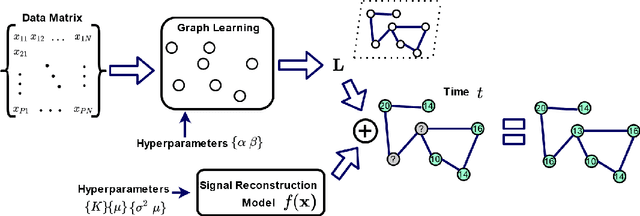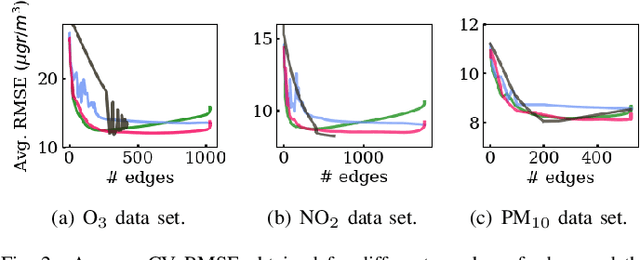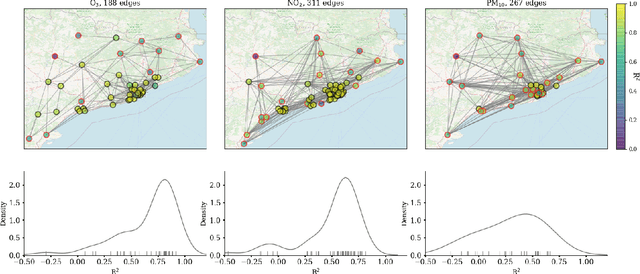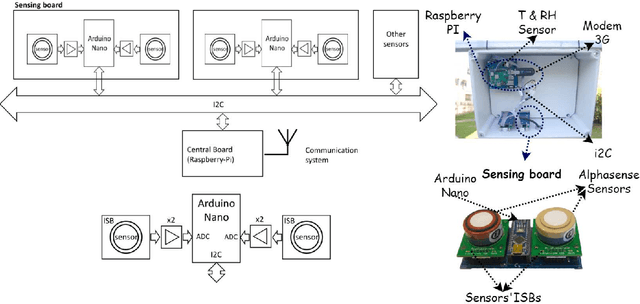Jose M. Barcelo-Ordinas
A Review of Graph-Powered Data Quality Applications for IoT Monitoring Sensor Networks
Oct 28, 2024Abstract:The development of Internet of Things (IoT) technologies has led to the widespread adoption of monitoring networks for a wide variety of applications, such as smart cities, environmental monitoring, and precision agriculture. A major research focus in recent years has been the development of graph-based techniques to improve the quality of data from sensor networks, a key aspect for the use of sensed data in decision-making processes, digital twins, and other applications. Emphasis has been placed on the development of machine learning and signal processing techniques over graphs, taking advantage of the benefits provided by the use of structured data through a graph topology. Many technologies such as the graph signal processing (GSP) or the successful graph neural networks (GNNs) have been used for data quality enhancement tasks. In this survey, we focus on graph-based models for data quality control in monitoring sensor networks. Furthermore, we delve into the technical details that are commonly leveraged for providing powerful graph-based solutions for data quality tasks in sensor networks, including missing value imputation, outlier detection, or virtual sensing. To conclude, we have identified future trends and challenges such as graph-based models for digital twins or model transferability and generalization.
Graph Signal Reconstruction Techniques for IoT Air Pollution Monitoring Platforms
Jan 02, 2022



Abstract:Air pollution monitoring platforms play a very important role in preventing and mitigating the effects of pollution. Recent advances in the field of graph signal processing have made it possible to describe and analyze air pollution monitoring networks using graphs. One of the main applications is the reconstruction of the measured signal in a graph using a subset of sensors. Reconstructing the signal using information from sensor neighbors can help improve the quality of network data, examples are filling in missing data with correlated neighboring nodes, or correcting a drifting sensor with neighboring sensors that are more accurate. This paper compares the use of various types of graph signal reconstruction methods applied to real data sets of Spanish air pollution reference stations. The methods considered are Laplacian interpolation, graph signal processing low-pass based graph signal reconstruction, and kernel-based graph signal reconstruction, and are compared on actual air pollution data sets measuring O3, NO2, and PM10. The ability of the methods to reconstruct the signal of a pollutant is shown, as well as the computational cost of this reconstruction. The results indicate the superiority of methods based on kernel-based graph signal reconstruction, as well as the difficulties of the methods to scale in an air pollution monitoring network with a large number of low-cost sensors. However, we show that scalability can be overcome with simple methods, such as partitioning the network using a clustering algorithm.
Sensor Sampling Trade-Offs for Air Quality Monitoring With Low-Cost Sensors
Dec 14, 2021



Abstract:The calibration of low-cost sensors using machine learning techniques is a methodology widely used nowadays. Although many challenges remain to be solved in the deployment of low-cost sensors for air quality monitoring, low-cost sensors have been shown to be useful in conjunction with high-precision instrumentation. Thus, most research is focused on the application of different calibration techniques using machine learning. Nevertheless, the successful application of these models depends on the quality of the data obtained by the sensors, and very little attention has been paid to the whole data gathering process, from sensor sampling and data pre-processing, to the calibration of the sensor itself. In this article, we show the main sensor sampling parameters, with their corresponding impact on the quality of the resulting machine learning-based sensor calibration and their impact on energy consumption, thus showing the existing trade-offs. Finally, the results on an experimental node show the impact of the data sampling strategy in the calibration of tropospheric ozone, nitrogen dioxide and nitrogen monoxide low-cost sensors. Specifically, we show how a sampling strategy that minimizes the duty cycle of the sensing subsystem can reduce power consumption while maintaining data quality.
 Add to Chrome
Add to Chrome Add to Firefox
Add to Firefox Add to Edge
Add to Edge